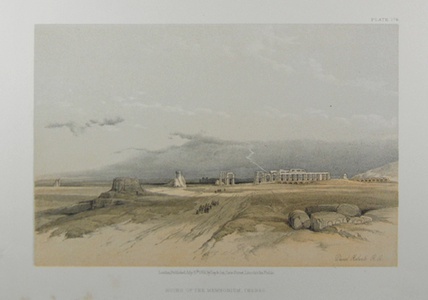| Method | Lithograph with tint stone |
| Artist | after David Roberts |
| Published | London, Published July 15th. 1856, by Day & Son, Gate Street, Lincoln's Inn Fields |
| Dimensions | Image 140 x 212 mm, Sheet 205 x 285 mm |
| Notes |
Plate 176 from Volume 5 of the small format reprint of Roberts' The Holy Land, Syria, Idumea, Arabia, Egypt & Nubia. A general view of the Ramesseum of Thebes, near the modern city of Luxor, Egypt. The Ramesseum was built as a mortuary temple for the nineteenth dynasty pharoah, Ramesses II, in the necropolis of the New Kingdom capital of Thebes. Like many of Ramesses' monuments, the Ramesseum is replete with iconography referencing the pharaoh's victory over the Hittites at the Battle of Kadesh, and also contains some of the largest pharaonic sculptures ever built. Of particular interest are two massive sculptures of Ramesses, the famous 'Younger Memnon,' removed from the site by the adventurer and archaeologist Giovanni Belzoni and now in the British Museum, and the 'Ozymandias Colossus,' a fallen statue commonly associated with the famous poem by Percy Bysshe Shelley, which, when standing, would have stood a remarkable 19 metres high. In Roberts' view, the ruins of the Temple are shown on the Theban plain, with storm clouds rolling in across the broad sky. A party of travellers approach the site along a wide road, passing architectural fragments and outcrops of rock evocative of Shelley's 'vast and trunkless legs of stone.' David Roberts RA (24th October 1796 – 25th November 1864) was a Scottish painter. He is especially known for a prolific series of detailed prints of Egypt and the Near East produced during the 1840s from sketches made during long tours of the region (1838-1840). This work, and his large oil paintings of similar subjects, made him a prominent Orientalist painter. He was elected as a Royal Academician in 1841. The firm of Day & Haghe was one of the most prominent lithographic companies of the nineteenth-century. They were also amongst the foremost pioneers in the evolution of chromolithography. The firm was established in 1823 by William Day, but did not trade under the moniker of Day & Haghe until the arrival of Louis Haghe in 1831. In 1838, Day & Haghe were appointed as Lithographers to the Queen. However, and perhaps owing to the fact that there was never a formal partnership between the two, Haghe left the firm in the 1850's to devote himself to watercolour painting. The firm continued as Day & Son under the guidance of William Day the younger (1823 - 1906) but, as a result of a scandal involving Lajos Kossuth, was forced into liquidation in 1867. Vincent Brookes bought the company in the same year, and would produce the caricatures for Gibson Bowles' Vanity Fair magazine, as well as the illustrations for Cassells's Poultry Book, amongst other commissions. Condition: Light foxing to margins, not affecting image. |
| Framing | unmounted |
| Price | £30.00 |
| Stock ID | 39153 |

